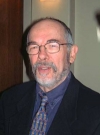John Rickard

John Rickard is the author of Australia: A Cultural History (2017). In his youth he worked as an actor and singer.
There is no Australian city other than Melbourne which could have produced Keith Dunstan,’ writes Barry Humphries in his foreword to this collection. Indeed, Dunstan, journalist and writer, has long been a Melbourne institution, particularly remembered for his daily column in the Sun News-Pictorial, ‘A Place in the Sun’. While working as a journalist, he was also busy as a writer of popular ... (read more)
A review of the Malthouse Theatre production of Patrick White’s ‘The Ham Funeral’, playing in repertory with Tom Wright’s ‘Journal of the Plague Year’, April 11 to May 9.
Patrick White had rather more success than Henry James with his plays – though that is not saying much. James’s attempt in the 1890s to conquer the London stage was a theatrical and personal disaster, but has, re ... (read more)
In the movie The Producers (now a musical), Gene Wilder accuses Zero Mostel of treating actors like animals. ‘Have you ever seen an actor eat?’ is Mostel’s pithy reply. There is a truth buried in this joke: eating can be important to actors in a profession where much time can be spent between jobs, ‘resting’, as it is euphemistically called.
Every year, at least 150 students graduate fr ... (read more)
In the era of gay liberation, ‘coming out’ has for many taken on the character of a religious experience. Gays and lesbians in the US draw easily on a religious culture of personal salvation even while denying the sometimes oppressive institutions it has created. In Australia, we are not given to the same public display of emotional and spiritual commitment, but ‘coming out’ has neverthele ... (read more)
On the eve of the recent history summit, Education Minister Julie Bishop told an audience, which included some notable historians, that history was not peace studies, nor was it ‘social justice awareness week’, nor, for that matter, ‘conscious-raising about ecological sustainability’. History, she declared, was simply history: though when she went on to assert that ‘there was much to be ... (read more)
Michael Bernard Kelly is perhaps best known for his association with the Rainbow Sash Movement, a group of gay and lesbian Catholics and their supporters who have, from time to time, been refused Holy Communion when attending Mass wearing the rainbow sash. Cardinal Pell, formerly archbishop of Melbourne, now of Sydney, has been a particular target. Kelly describes himself as the movement’s ‘wr ... (read more)
What is it that endows an actor or performer with stage presence? Jane Goodall introduces her exploration of this phenomenon with three disparate examples: Maria Callas commanding an audience of 20,000 at Epidauros, including a ten-year-old girl who would never forget the experience; Bob Dylan recalling the professional wrestler Gorgeous George making an entrance ‘in all his magnificent glory’ ... (read more)
Alfred Felton, bachelor who lived for many years in boarding houses of one kind or another, might seem a familiar Victorian figure, particularly in a colony where there were not enough women to go around. But Felton was a bachelor with a difference. In the first place, as the co-founder of the prosperous drughouse Felton, Grimwade and Co., he was a colonial success story. He also had interests bey ... (read more)
Masculinity isn’t what it used to be. To begin with, it has gone forth and multiplied to become masculinities, for it is a requirement of a pluralist culture that diversity not only be acknowledged but cultivated. What has happened, of course, is that as women’s history has given way to gender studies, masculinity, which was formerly taken for granted as part of the dominant culture, is being ... (read more)
